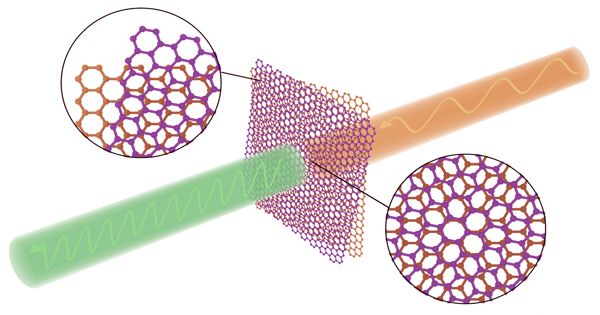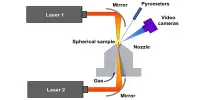Electrons in materials have a property known as ‘spin’ which is responsible for a variety of properties, the most commonly known of which is magnetism. Permanent magnets, like those used for refrigerator doors, have all the rotations in their electrons aligned in the same direction. Scientists refer to this behavior as ferromagnetism, and to the research field of trying to manipulate spin as spintronics.
By combining ferromagnets and two rotated layers of graphene, researchers open up a new platform for strongly interacting states using graphene’s unique quantum degree of freedom.
Graphene is an allotrope of carbon consisting of a single layer of atoms arranged in a two-dimensional honeycomb lattice. The name is a portmanteau of “graphite” and the suffix -ene, reflecting the fact that the graphite allotrope of carbon consists of stacked graphene layers.
Down in the quantum world, spins can be arranged in more exotic ways, giving rise to frustrated states and entangled magnets. Interestingly, a spin-like property, known as “the valley,” appears in graphene materials. This unique feature has given rise to the field of valleytronics, which seeks to exploit valley property for emerging physics and information processing, much as spintronics relies on pure spin physics.
‘Valleytronics would potentially allow information to be encoded in the quantum valley with a degree of freedom, similar to how electronics do it with charge and spintronics with spin.’ explains Professor Jose Lado of the Department of Applied Physics of Aalto and one of the authors of the work. ‘Moreover, valleytronic devices would offer a dramatic increase in processing speeds compared to electronics and a much higher stability towards magnetic field noise compared to spintronic devices.’

Structures made of rotated, ultra-thin materials provide a rich solid-state platform for the design of novel devices. In particular, slightly twisted graphene layers have recently been shown to have exciting unconventional properties that can ultimately lead to a new family of materials for quantum technology. These unconventional states that are already being explored depend on electrical charge or spin. The open question is whether the valley can also lead to a family of exciting states.
Making materials for valleytronics
For this purpose, conventional ferromagnets have a vital role to play, pushing graphene to the realms of valley physics. In a recent work with Profs, Tobias Wolf, a Ph.D. student. Oded Zilberberg and Gianni Blatter at ETH Zurich and Prof. Jose Lado at Aalto University have shown a new direction for correlated physics in magnetic van der Waals materials.
The team has shown that sandwiching two slightly rotated layers of graphene between a ferromagnetic insulator provides a unique setting for new electronic states. The combination of ferromagnets, graphene twisting and relativistic effects forces the “valley” property to dominate the behavior of electrons in the material. In particular, the researchers have shown how these valley-only states can be electrically tuned, providing a material platform in which valley-only states can be generated.
Building on a recent breakthrough in spintronics and van der Waals materials, valley physics in magnetic twisted van der Waals multilayer opens the door to a new realm of correlated twisted valleytronics.
‘Demonstrating these states is the starting point for new exotic entangled valley states.’ Professor Lado said, ‘Ultimately, the engineering of these valley states can enable quantum entangled valley liquids and fractional quantum valley Hall states to be realized. These two exotic states of matter have not yet been discovered in nature and would open up exciting possibilities for a potentially new graphene-based platform for topological quantum computing.”















